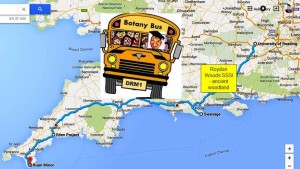Dr M plus colleague Alastair Culham and University of Reading MSc students packed luggage, equipment and themselves in the botany bus and set off on the botanical eXtravaganza which is the Plant Diversity field course.
From Reading the botany bus wound its way through the Berkshire Countryside to Hampshire, bound for Roydon Woods Site of Special Scientific Interest, the first stop on this two week botanical bonanza.
Roydon Woods SSSI is a Hampshire and Isle of Wight Naturalists Trust nature reserve of extensive deciduous woodland in the valley of the Lymington River, adjoining the New Forest.
- eXtreme bonsai botany in the carpark
- Equisetum telmateia (Great Horsetail)
- Heading for Pine plantation
After the usual extended stop in the carpark to ID impossibly minute trampled plant species we moved into the woods.
The group encountered a range of woodland types and in addition to extensive planted woods with Pinus spp. we found three distinct types:
- Quercus rubur (Pedunculate Oak) and Corylus avellana (Hazel) with abundant Primula vulgaris (Primrose) – the most diverse and species rich woodland type we found here marking out the richer, moister soils.
- Fagus sylvatica (Beech) and Rubus fruticosus (Bramble) with the calcifugous mosses Leucobryum glaucum and Polytrichastrum formosum clearly indicating free-draining, very dry and acid soils.
- Salix cinerea (Grey Willow) and Betula pubescens (Hairy Birch) woods in much wetter areas with Molinia caerulea (Purple Moor-grass) and Sphagnum species (Bog Moss).
- Primroses in the woods
- Acid woodland with Beech and Holly
- Wet woodland with Willow, Birch and Purple Moor-grass
In contrast to the neighbouring New Forest, but on similar soils, the woodland is ungrazed and as a result it is conspicuously more luxuriant and rich in species than the Forest woodlands.
According to the SSSI schedule there are 270 species of flowering plants and 62 of these are considered to be indicative of a long continuity of woodland cover (AWI).
- Spectacular garden flowers
- Alastair through the looking glass
- Recently burnt Gorse heath
After the woods we headed back to the #Botanybus2015 via some gardens with … and an area of recently burned Ulex europaeus (Gorse) scrub.
Next stop the Chatsworth Centre, Swanage to continue the trip with an investigation of the plant communities of the Poole Basin in Dorset.











